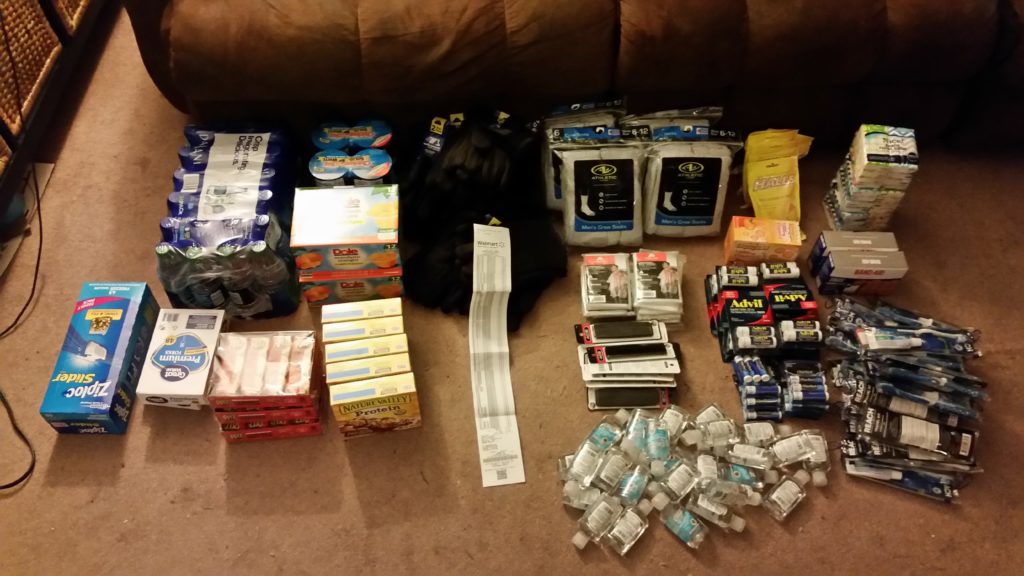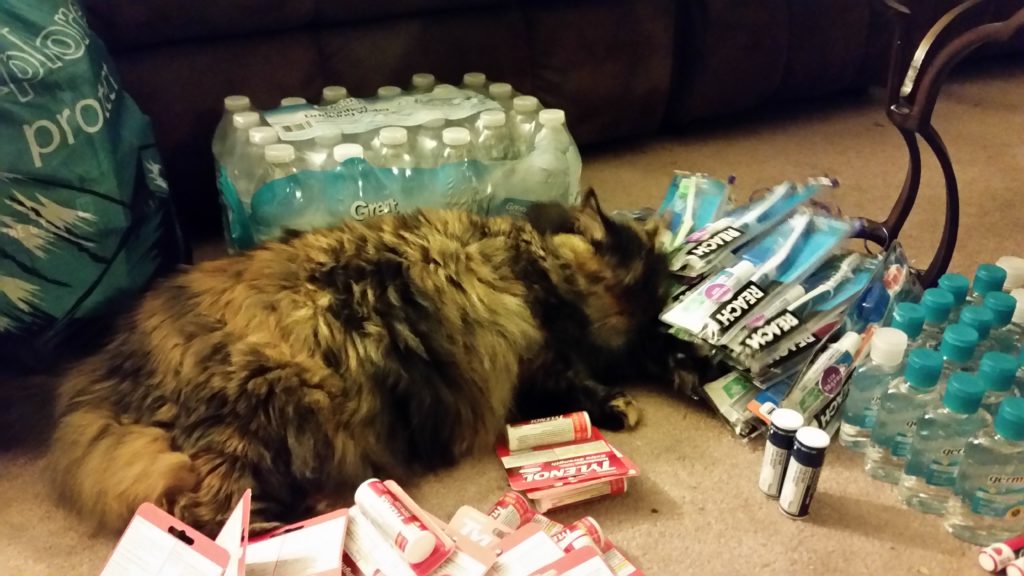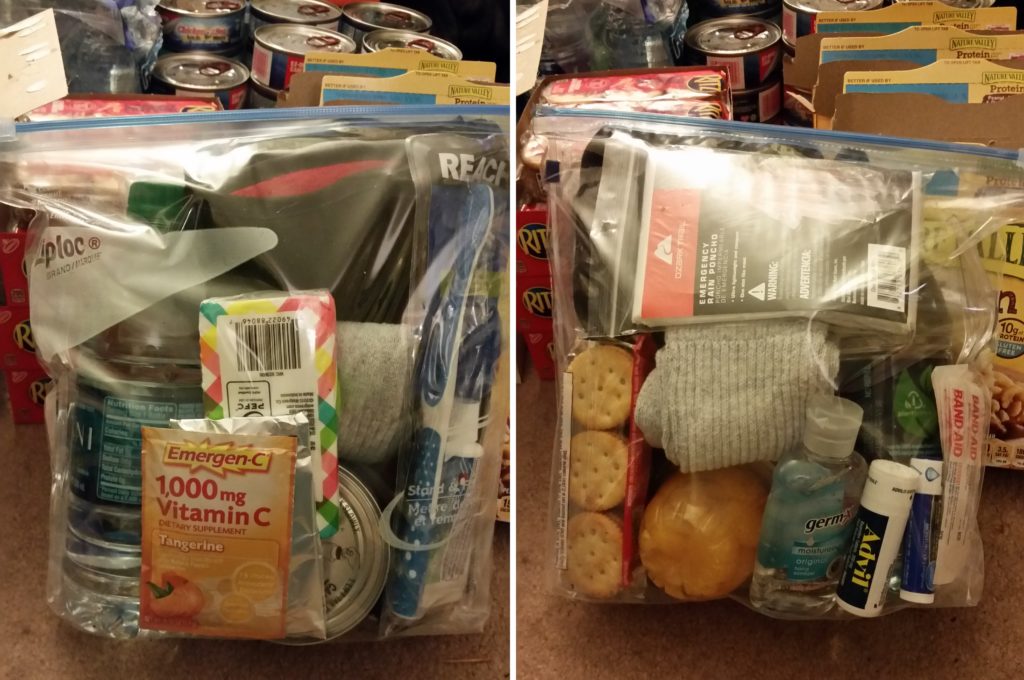If you live in or near a city, you probably see a large number of homeless, traveling, or down-on-their-luck people asking for money, food, or work near stoplights and street corners. For a couple years now, I have tried to have something a little more substantial than money on hand to give them. While I have seen many people provide gifts and necessary items to people in this situation between Thanksgiving and Christmas, I usually try to keep something helpful on hand after Christmas is over, when the weather gets worse and many of us tend to forget about the “peace on earth and goodwill toward men” spirit that we feel around the end of December.

Pros and Cons of this type of assistance
As with every issue, there are multiple perspectives around helping individuals who are on the street, and although it seems like something that would be difficult to object to, there are concerns. The biggest objections I have heard around this practice are:
- Giving handouts encourages more begging, and those resources could be better used to support systems to help the homeless.
- It can be dangerous encountering any stranger on the street.
- Giving something other than money presumes that you (the giver) know better than the recipient what the recipient needs.
I won’t disagree that the money I put into making kits to give away as I encounter people in need could instead go to a shelter and possibly help more people in a more organized fashion. However, the people I see can’t always get themselves to a shelter (for lack of transportation) or don’t know where they can find help. Additionally, I would like to point out that while making systematic changes are important for long-term support of in-need populations, that doesn’t help the person who is starving today.
I won’t disagree that the second point is valid. If you’re going to go around town and actually hand out care packages (rather than handing them out of your car window at a stoplight), it’s safer to go in pairs or groups.
And I certainly won’t disagree that my privilege is showing when I dictate what I believe to be best for someone and give them supplies rather than money. Money is more flexible in terms of meeting unforeseen needs and can be much more useful. However, I have seen someone take money from a car and walk immediately into a gas station to buy a pack of cigarettes. It is an ethical debate to be sure, but I fully admit my privilege in selecting this course of action while also working to identify items that may be necessary but not commonly thought of.
What to Include
There are some good resources for commonly-needed items either at homeless shelters or in these care packages, which I was sure to reference before I made my first ones.[1] Here is a list of items I have included in the past:
- Water bottle
- Can of tuna (dolphin-safe, of course!)
- Fruit cup
- Granola bar
- Peanut butter crackers
- Plastic fork and spoon
- Socks
- Gloves
- Band-Aids
- Cough drops (wrapped in tin foil)
- Emergen-C packet
- Comb
- Toothbrush & toothpaste
- Hand sanitizer
- Chapstick
- Ibuprofen
- Kleenex
- Plastic poncho
- Printed card of local resources (shelters, soup kitchens, etc.)

A new suggestion that I noticed this year was the inclusion of Maxi pads. I have never thought to include these before, but it makes a lot of sense. Most of the recipients of my care packages over the years have been male, but not all of them. Menstrual products are highly useful when needed (and highly forgettable when not.)
Here are a couple things to think about if you plan to include menstrual products:
- While Maxi pads are personally my least favorite option (both in terms of comfort and in generating trash after they’ve been used), they are probably the best option for someone who needs to use them while possibly not having access to a bathroom.
- The statistics on the number of transgender men and women (specifically teens) who are homeless is downright alarming.[2] I had initially considered creating gendered care packages upon hearing the recommendation of Maxi pads, but sometimes it’s hard to tell who has a uterus.
- Even if you don’t need a pad as a menstrual product, I know they come in handy soaking up blood from wounds. I know men who have used them on incisions after surgeries. I will probably include them in all of my kits moving forward.
Wrapping Up
When I assemble these packages, I do them all at once, and I make 24, which I have found to be a convenient quantity, as many of the components come in sets of 6, 8, or 12. You don’t have to do something on that scale though, as it can get expensive. My total bill at the store is usually around $300 for all of the supplies.
Alternately, if you can’t or don’t want to make a whole kit, you can keep granola bars or individually-wrapped snacks in your car, or even gift cards to pharmacies/convenience stores. Another option is if you go out to eat, packing up your leftovers in a to-go container and handing it to someone on the street on your way out.

The only part of this process that really bothers me is the one-time-use packaging on a lot of these items. It’s a trade-off. I have some wooden, compostable flatware on hand (still left over from my wedding reception), and I may pack some of those in my kits this year, but that doesn’t solve the problem of the single-use wraps around granola bars and plastic fruit cups, not to mention the plastic bottles of water.
On the other hand, I can’t in good conscience tell someone that I can’t give him anything that will help him because it will be worse for the environment. An option I might explore in the future is to make food at home and wrap it in something biodegradable, such as parchment paper. Fresh fruit can be a sustainable alternative to a plastic fruit cup, but keep in mind that some people may have damaged, weak, or missing teeth – chewy is preferable to crunchy in all food choices.
My process changes a little every year, as do the contents of the care packages. What doesn’t change is how appreciative people are when they feel seen.
“Would that we could always see such spirit through the year.”
– A Charlie Brown Christmas
Thank you for reading.
[1] https://www.portlandrescuemission.org/get-involved/learn/pack-a-care-kit/
[2] https://nationalhomeless.org/wp-content/uploads/2017/06/LGBTQ-Homelessness.pdf
4 Comments
Julia Zebley · January 5, 2020 at 11:32 am
Wow, this is really great!
When I was in AmeriCorps, I used to volunteer for a walk through the city where we would hand out similar care packages to people experiencing homelessness, although we had backpacks with particular items for distribution. The thing they emphasized to me about food stuffs–which I would only note in reference to the granola bars–is they only gave out “soft” foods due to the high probability of poor dental situations that make chewing difficult. In that regard, for fresh fruit they recommended bananas.
Another great idea I saw is giving out $10 gift cards to McDonald’s or Subway, as those are fast food restaurants Downtown, where a lot of people experiencing homelessness congregate, and it gives them some choice in how they use the funds.
Alison · January 5, 2020 at 12:13 pm
Thank you – I didn’t know you were in AmeriCorps!
And yes, I really like the gift card idea too. I feel like allowing someone to choose what to eat can go a long way in helping that person retain some dignity.
Charles Korey · January 5, 2020 at 4:49 pm
I think this is a wonderful gesture
Tidying Up, Week 5 – Miscellaneous – Radical Moderate · March 14, 2021 at 10:02 am
[…] [2] https://radicalmoderate.online/care-packages-for-homeless-people/ […]